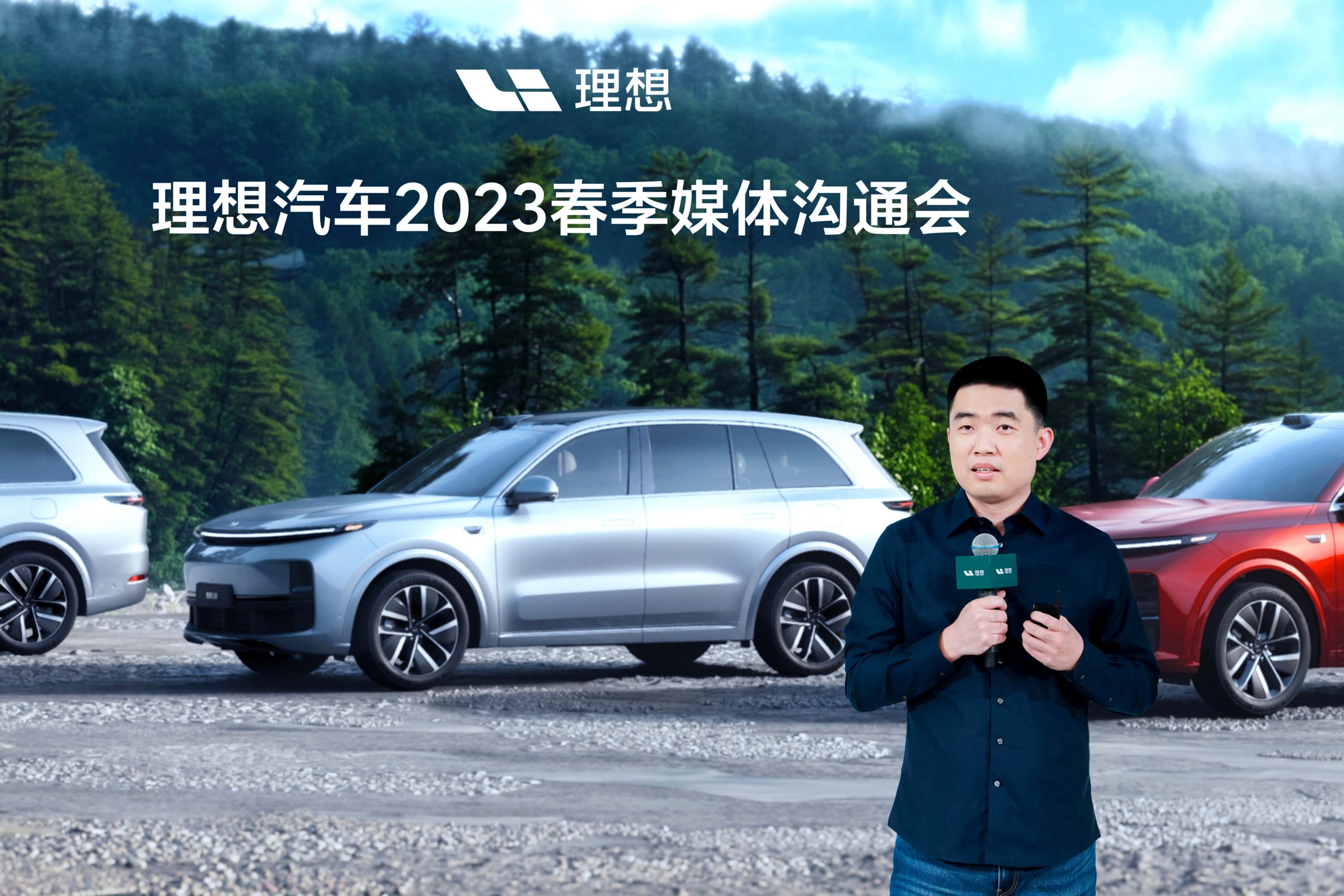The Three Questions of Idealism: Who am I? Where do I come from? Where am I going?
Although these questions were first raised in the philosophical context, they are widely present in human curiosity generated by exploration. Their essence is not to make us fall into pessimism and emptiness, but to know that after asking a big and broad question, we need to calm down and continue to ask deeper and more essential “second-order questions”.
Therefore, when I sat in Beijing Ideal R&D Center and saw these three questions appear on the screen, I couldn’t help but feel pleasantly surprised.
From Li Xiang’s selection of car manufacturing as his third entrepreneurial goal in 2015, to the brink of survival due to failed financing at the end of 2018 and early 2019, to the production of the 100,000th Ideal ONE in October 2021, becoming the new force’s fastest car to break the 100,000 production mark, and to the excellent market feedback of L8/L9, eight years have passed in a flash.
At the time when Ideal announced “moving towards billion-dollar revenue”, Li Xiang chose to review his thinking and insights about the road he had taken in such a special way, which also had deep implications for both continuation and innovation.
From the thinking about the birth of the enterprise to where it is going, Li Xiang gave us a philosophical lesson about Ideal’s enterprise in two hours.
“Who am I”, only 1% of new forces understand
“Among the more than 300 new car manufacturers, only 1% of companies are qualified in terms of brand.” Li Xiang was still outspoken at the media communication meeting as before.
“Today it is said that I want to have a family car, and tomorrow it is said that I want a three-second acceleration. (These companies) all have a confused logic. This will affect their subsequent products and affect all aspects of operation.”
In Li Xiang’s view, “brand” is the brain of the enterprise and the origin from top to bottom. Externally, users need to understand who you are; internally, the team needs to understand who you are. For Ideal, the core positioning from the very beginning was “the preferred luxury electric car brand for families”.
听起来很空对不对?事实上,在理想 ONE 诞生的初期,收获的怀疑并不少:<del>「增程也配叫新能源?」、「挂绿牌去加油站的可笑产物」、「1.5T 卖 30 万的韭菜收割机」</del>。
李想称,<strong>大部分消费者其实不清楚自己明确的需求</strong>。在没实际接触产品之前,问你要不要增程?要不要娱乐屏?要不要好用的辅助驾驶?消费者不了解这些新东西带来的体验提升,自然不会觉得自己需要。<strong>但是真的带着家人、孩子、老人出行,真的被辅助驾驶减缓压力,感受过大电池增程的体验时,就会发现自己选择的产品已经超越了当初的预期。</strong>
<strong>所以,「做正确的事,不做容易的事」是理想定下的价值观。当然,想要事情做得正确,作为企业头脑的「品牌」就必须明确,不然就会「越努力,越失败」。</strong>
关于当初理想 ONE 选择增程的初衷,理想也罕见地提到了蔚来的换电体系。李想认为「<strong>消费者没有义务在购买电动车后降级自己的体验、出行半径、出行效率</strong>」。
「换电是一个非常好的方式,体验可以无限接近加油的体验,用户的用车成本也会大大低于燃油车。但是这花费太大,我们当时钱不多。换电站需要建,也要准备更多的电池,电池的价格又会波动。<strong>所以我们在想,能不能直接从产品端解决问题,而不依赖服务端。</strong>」
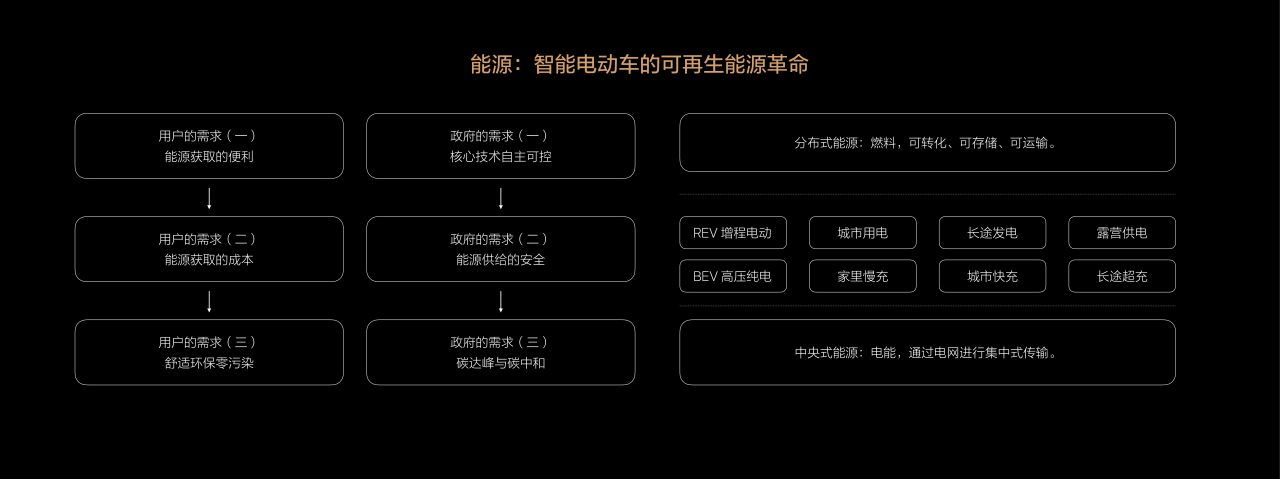
和东施效颦理想的对手们相比,销量表现不佳的表现可能是一开始就没有回答好「我是谁」、「我要满足消费者什么需求」、「我为什么要做增程」。<strong>回归事物最基本的条件,将其拆分成各要素进行解构分析,从而找到实现目标最优路径的方法。</strong>
<strong>从这一点上来说,李想的思维模式和我们耳熟能详的「第一性原理」颇为相似。</strong>
对于一家新能源车企而言,李想认为现在需要思考的问题和 2016 年理想 ONE 立项时一样:<strong>怎么解决充电难和电池成本高的问题。</strong>
“`
Currently, there are 300 million fuel vehicles and 2.4 million gasoline pumps in China, while there are 10 million electric vehicles and 3.6 million charging stations. Unlike the car-to-pump ratio of 125:1, the car-to-charging-station ratio of 3:1 still faces the “charging difficulty” primarily due to insufficient power recharging, rather than insufficient battery capacity.
Therefore, with 800V technology matured, the ideal pure electric plan is put forward. Through 800V technology, a significant mileage can be recharged within 10 minutes, making the “turnover rate” of charging stations increased. In addition, Li Xiang also hinted that there may be batteries with two discharge rates in the future: 4C cells can achieve a range of 400km in 10 minutes, while 2C cells can achieve a range of 400km in 20 minutes. High-voltage fast charging networks and high-rate batteries must be integrated.
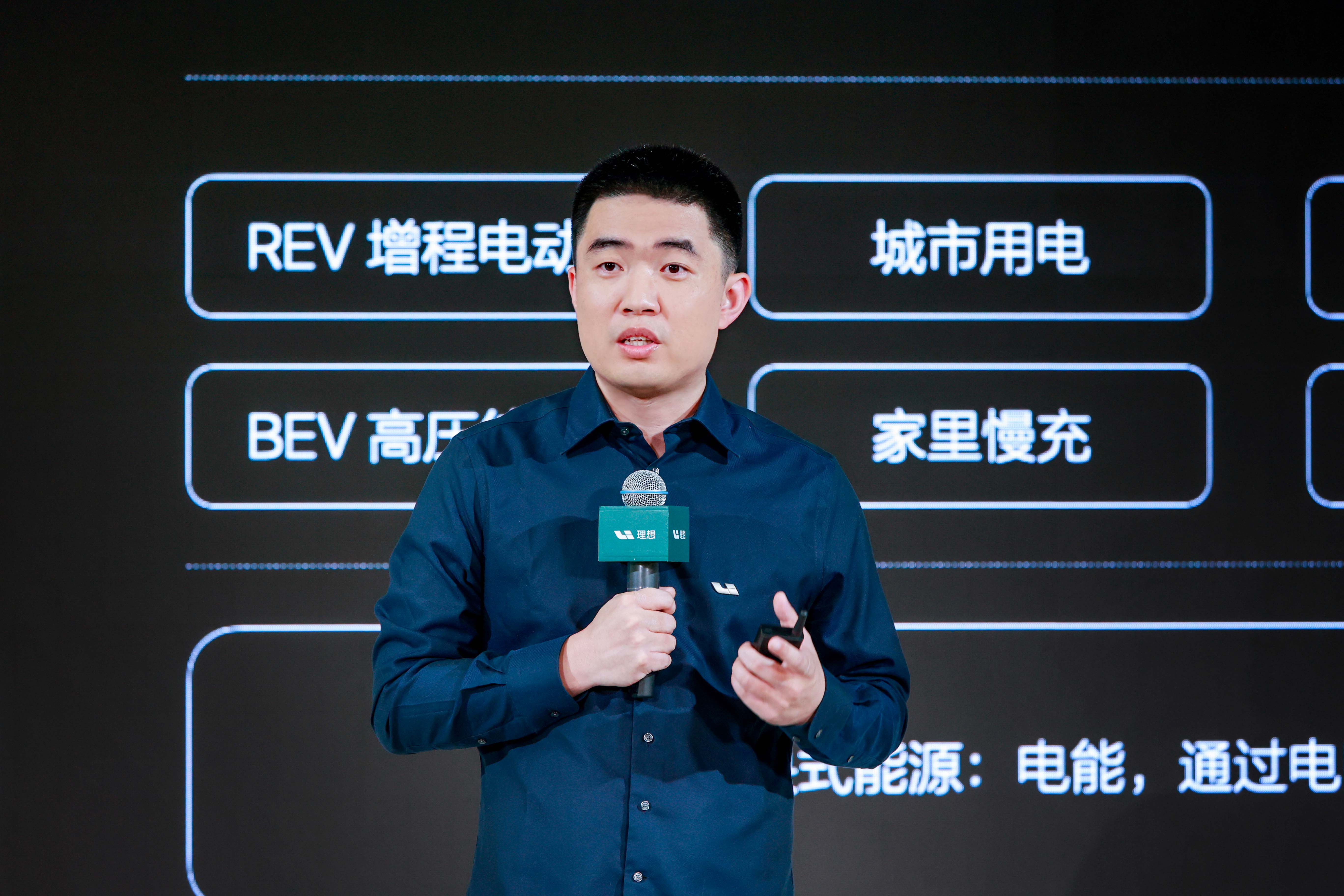
For the cost-focused “frugal factory” like Ideal, 800V technology has also brought significant cost improvement: “For example, currently, the best-selling pure electric medium-to-large SUV can achieve a 100kWh battery pack with a range of 600km, and the optimization of 800V and SiC components plus the overall energy consumption can enable an 80kWh battery to achieve a range of 600km as well.“
Li Xiang said that compared with the mainstream 400V architecture electric vehicles, with the same size and driving form, the use of 800V can reduce the components cost of a car by RMB 30,000 to RMB 40,000.
Looking forward, Li Xiang said that he would continue to pursue two lines of development until 2030: on the one hand, improving the range extension efficiency; on the other hand, making every effort to research and develop high-voltage pure electric vehicles.
After a good performance at the financial report conference, Li Xiang showed a little bit of “Versailles”:
“In the 0-1 stage, the range extender enabled us to gain considerable revenue. In the past few months, the revenue of Ideal Automobile ranks third, only after BYD and Tesla. Such revenue and scale can support us to go all out to do pure electric vehicles next.”
From Lee Xiang’s speech, it can be seen that even in the pure electric products on the 800 V high-voltage platform, reducing costs while ensuring the experience is the core, which is consistent with the theme of Tesla’s MASTER PLAN 3.
To some extent, most domestic new automakers have shadowed Tesla, and Li Xiang can be said to be the one who learned the most from it.
“Where to go”, first check if you are “healthy”
“By 2030, we are committed to becoming the world’s leading artificial intelligence company, whether it is the top three or five companies, we hope that we will definitely be one of them.”
This is the grand goal that Li Xiang set since 2015, and it has not changed until now. However, answering the question of “where to go” is a grand proposition. At that time, Li Xiang was in the stage of 0-1 and 1-10. Looking up at the sky and walking forward will definitely encounter obstacles.
Stabilizing the internal is needed when dealing with external matters. To answer the question of “where to go,” we must first look at whether the people walking have enough health. Without a healthy operating system, companies will either encounter various problems during rapid expansion, or die before dawn.
This picture summarizes Li Xiang’s business philosophy. Among them, brand, R&D, delivery, and gross profit margin revolve around Li Xiang’s most advantageous “product strength.”
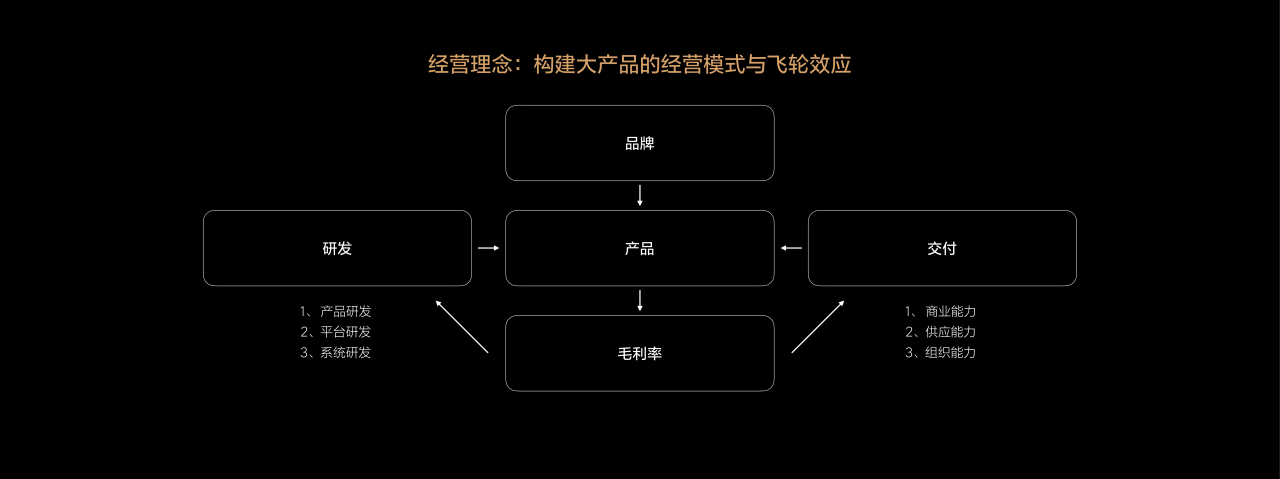
When it comes to high-end coffee, you think of Starbucks; when it comes to Li Xiang, you think of “mobile home”. Therefore, in terms of brand building, Li Xiang has already penetrated deeply into people’s hearts. In terms of products, Li Xiang believes that safety, value, and longing are the three core elements.
“Safety is the bottom line. For example, using high-strength steel and hot-formed steel on the A-pillar cost only a few hundred yuan more, but many companies insist on saving these few hundred yuan; we use the best aluminum structure for the anti-collision beam at the tail of the wheel eyebrow, which costs more than 1,000. Including the head airbags and side air curtains in the second row, the overall cost is only about 2,000 more.”
In the market that has been educated by joint venture automakers, there was once a vicious cost control habit of reducing airbags for low-end models and optimizing biased collisions and tests only for one side. Facing family-oriented ideals, the starting point is still consumers: ensuring that every passenger in every seat is safe.“`
Product Value is Divided into “Software” and “Hardware”. “The core of the software part is that when I can achieve self-developed central domain controller and intelligent driving controller, along with self-developed entire software, then that is not a problem”.
Li Xiang used his own “Mission Master” as an example just after the OTA: “The interface supplier for these software and hardware is not open to you. For the degree of self-development, it depends on which functions you can customize. In addition to software, we can even call hardware together.”
Li Xiang also acknowledged: “the most difficult is hardware.” He used 52 poker cards as an example: “For every additional function, one has to be removed. It is not a matter of adding as many.” As for the choice of these, Li Xiang gave two examples.
The first example is why L7 did not follow the Mercedes-Benz S-Class and BMW 7 Series to achieve seat cushion-backrest linkage adjustment. Li Xiang explained that in order to ensure structural safety and the unity of the linkage function, the folding of the rear seat needs to be sacrificed. As a car serving families, the choice is clear.
The second example is whether the 3-second acceleration ability in the era of electric vehicles is necessary. If a 3-second acceleration is achieved, what will be sacrificed is energy consumption at medium and low speeds, and the size of the electric motor will also cause problems in space layout. In the development process of the ideal product, five strict steps are followed: Analysis of demand, verification of demand, component SOR, component verification, and whole vehicle verification.
How to make choices? Have you clearly understood the demand? Although it seems to be a simple question, it is actually the beginning and key to precise positioning of a good product.
Regarding the longing for the product, the four characters “moving home” are the best interpretation. In Li Xiang’s view, if his product is like a home, it needs to have the largest and most comfortable space; everyone can have a screen for entertainment at home, and the car interior space should be the same; in order to let intelligent driving bring a unified experience, NOA must be standard throughout the system.
“Do not just skim over the core configuration of the product, always exceed the investment and configuration. Otherwise, you may feel satisfied, but others will not.”
By understanding this sentence, you understand why Ideal’s products are always easy to remember, while competitors who have also put emphasis on “large seats,” “large space,” and “large screens” cannot receive the same amount of attention.
About gross profit margin, the total gross profit of Ideal Auto in 2022 Q4 is 3.566 billion, with an overall gross profit margin of 20.2% and a gross profit margin per vehicle of 20%. The total gross profit for the year is 8.79 billion, with an overall gross profit margin of 19.4% and a gross profit margin per vehicle of 19.1%. Although it did not exceed 20%, it is still very close.
Although XPeng's financial report has not been released, let's look at NIO's financial data: total gross profit of 622 million RMB in the fourth quarter and total gross profit of 5.144 billion RMB for the year. It is clear who is in a healthier state.
Both Ideal Auto and NIO are facing the challenge of product upgrades in 2022. **But from switching from Ideal ONE to L-series, Ideal's gross profit margin quickly recovered from 12% in Q3 to 20%, while NIO extended the battle to 2023.**
**Li Xiang said that a 20% gross profit margin is a sign of a healthy enterprise, and the enterprise has enough capital to promote research and development**. With a healthy Ideal Auto, it is only now answering the question of "where to go."
**For Ideal, the answer to this question is "Software 2.0."**
Software 1.0 refers to humans devising rules for machines, outlining boundaries, calibrating parameters, programming themselves, and finally using programs themselves. Today's Internet, terminal devices, and APPs also mostly operate in this mode.
Software 2.0 is when machines learn from humans, program themselves, formulate their own rules, and use them. **Li Xiang said: "We use a robot, but do not use any specific functions of the robot. The robot is autonomous."**
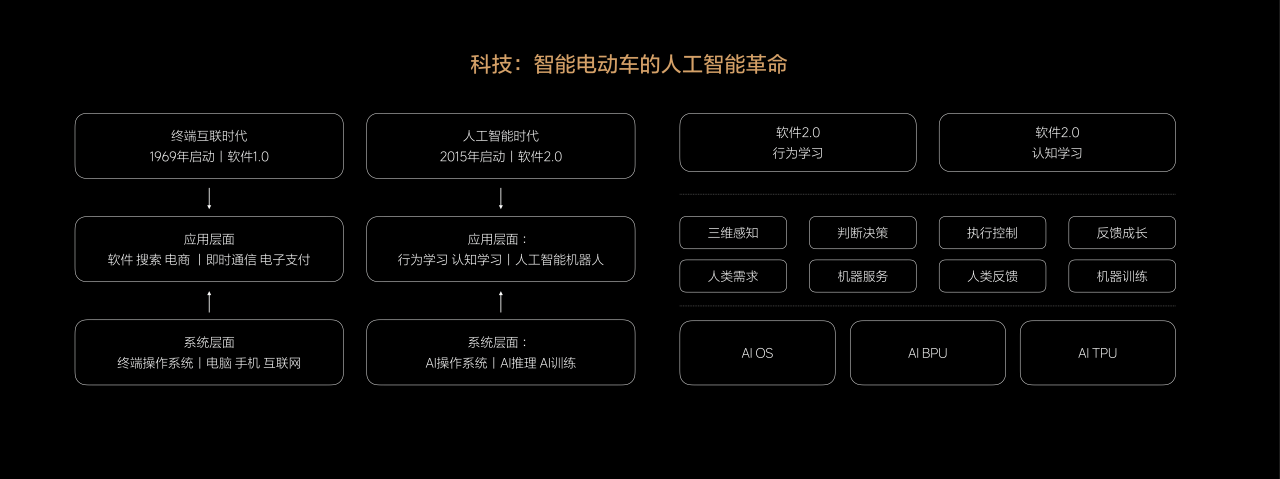
Ideal has established four AI algorithm teams to solve problems in four fields, namely the intelligent cockpit team for developing multimodal algorithms, the intelligent driving team, the intelligent factory team, and the retail end intelligent team.
The most imaginative work is done by the intelligent driving team. **Ideal, who is good at learning from Tesla, decided to follow Tesla's BEV (Bird's Eye View) technology path after seeing the success, transforming from the traditional camera outputting 2D plane information-human annotated route to the camera stitching a 360-degree panoramic view (bird's-eye view) outputting 3D perception + temporal information perception mode.**
```markdown
**At this time, the perception of vehicles is no longer two-dimensional images, but a 3D perspective with time information like humans. With the leap of perception, the way of judgment also becomes very different. Through "Shadow Mode," AI will compare and learn its judgment results with a human driver's response. The results of the training are uploaded to the cloud, and the cloud will automatically annotate, classify, and train. After obtaining a large model, the "Shadow Verification" is done directly on the car, rather than traditional bench simulations. This forms a closed loop of self-evolution.**
As long as there are enough samples for this "end-to-end" training, the entire driving experience and safety will become better and better, just like how humans work in various scenarios and go to school. Li Xiang's ideas are similar to those of Tesla, and he himself does not hesitate to say:
**"Personally, I believe that by the end of this year, most of the leading companies will be able to achieve Tesla's level at the end of 2011. By 2024, everyone will be able to achieve the level of Tesla in North America at the end of 2022 or the beginning of 2023. At that time, starting with mid- to high-end cars, we will completely enter the era of intelligent self-driving cars based on software 2.0."**
According to Li's ideal estimate, there is a gap of 2 years for the leading domestic automakers in the research and development of autonomous driving. In Li's opinion, since the "where to go" answer is "the world's leading artificial intelligence company", then the planning of Li Xiang's own AI training chips and supercomputing centers may also be "on the verge of completion" with reference to Tesla.
## "How to go", solve all problems through cooperation
**"We believe that organizations will actually encounter three different types of problems: laziness, inertia, and ignorance."**
Coming from an internet background, Li Xiang has experience managing software, solving weaknesses in industrial capabilities by introducing standard automotive R&D, experimentation, and manufacturing processes; and then, through OKR, solving the communication problem between two parts of the talent. In the era of multi-model platform, updated architecture is needed to help companies develop.
This is also the situation that Ideal is afraid of: the R&D of car companies and the process of research institutes are independent and cannot be integrated.
Therefore, Ideal introduced a matrix organizational structure. In the internal letter at the end of last year, Ideal officially launched an upgraded comprehensive matrix organizational structure for the billion-dollar revenue scale, replacing the previously vertical functional organizational management mode.
Under the new organizational structure, the new high-level structure of Ideal is:
- CEO Li Xiang himself oversees the “Product and Business Group”, responsible for strategy, products, brand, three terminals (retail, delivery, maintenance), charging network, etc.;
- The original chief engineer of iDeal, Ma Donghui, was promoted to president and entered the board of directors, in charge of “R&D and Supply Group”, overseeing R&D and supply chain;
- CTO Xie Yan is responsible for the “System and Calculation Group”, in charge of the construction of computational platforms, operating systems, system security, and intelligent cloud and other departments;
- CFO Li Tie is in charge of the “Organizational Financial Group”, with financial, administrative, financial, process and other departments, while Li Wenzhi serves as the head of the CFO office.
Under this organization, there are 7 physical departments: strategy department, product department, commercial department, supply department, process department, organization department, and financial department.
Finally, among these 7 horizontal management departments, 7 first-level processes are set respectively, corresponding to the following:
- DSTE (from strategy to execution)
- IPD (Integrated Product Development)
- IPMS (Integrated Product Marketing & Sales)
- ISC (Integrated Supply Chain)
- BT&IT, LTD, IFS (Integrated Financial Transformation)
In simple terms, the matrix organizational structure combines functional departments and product (project) division groups into a matrix. A manager not only maintains organizational and business connections with the original functional department, but also participates in the work of the project team.
The matrix structure is fixed, but personnel are changing. Project teams and leaders can be temporary and appointed, and they will be disbanded after the task is completed, with an unchanged task line.
“`”Organizational upgrade is the most important exam for companies to enter larger and more difficult stages. More than 90% of failed companies are not due to problems with their operations, but rather due to the inability to adapt to the expansion of organizational capacity and industry changes. This sentence is the best annotation on how to proceed.
Conclusion
At a communication meeting, Li Xiang said that the scariest thing in life is not knowing what you don’t know, and not being able to be objective. In an interview, Li Xiang said that building cars has truly changed him. When faced with countless excruciating problems, he begins to contemplate philosophical questions to help himself deal with complexity and see problems from a different perspective.
Li Xiang said that starting a business for the third time will go through five stages. The first stage is feeling different from others and staying in our own little world. The second stage is looking outward but not understanding. The third stage is not understanding and seeking help from high-level advisors or companies to help us understand. When we reach the third stage, we start understanding. In the fourth stage, we immediately take action after understanding, but then figure out that we cannot do it because we haven’t planned the road. In the fifth stage, we clearly know which consulting companies and teams were used to plan and build the roads of the company, and we bring them in to plan and build roads ourselves. At this point, the team will drive and transport on top, and the value efficiency will be higher.
Putting down the heavy burden of self, embracing cooperation and moving towards a scale of billions may be the underlying implication of this communication meeting. In fact, this is also the Buddhist interpretation of how to “break the ego attachment”.”
This article is a translation by ChatGPT of a Chinese report from 42HOW. If you have any questions about it, please email bd@42how.com.
